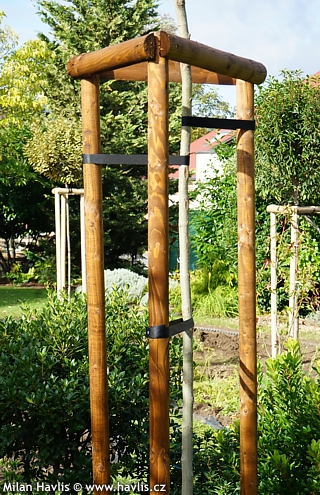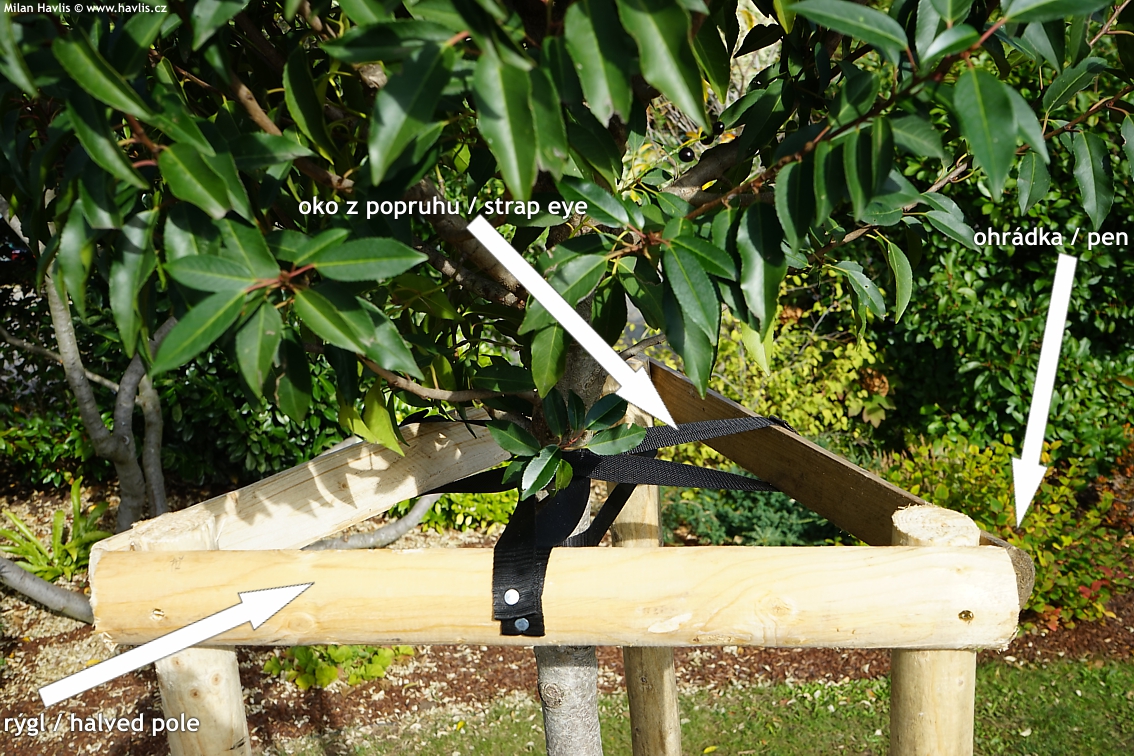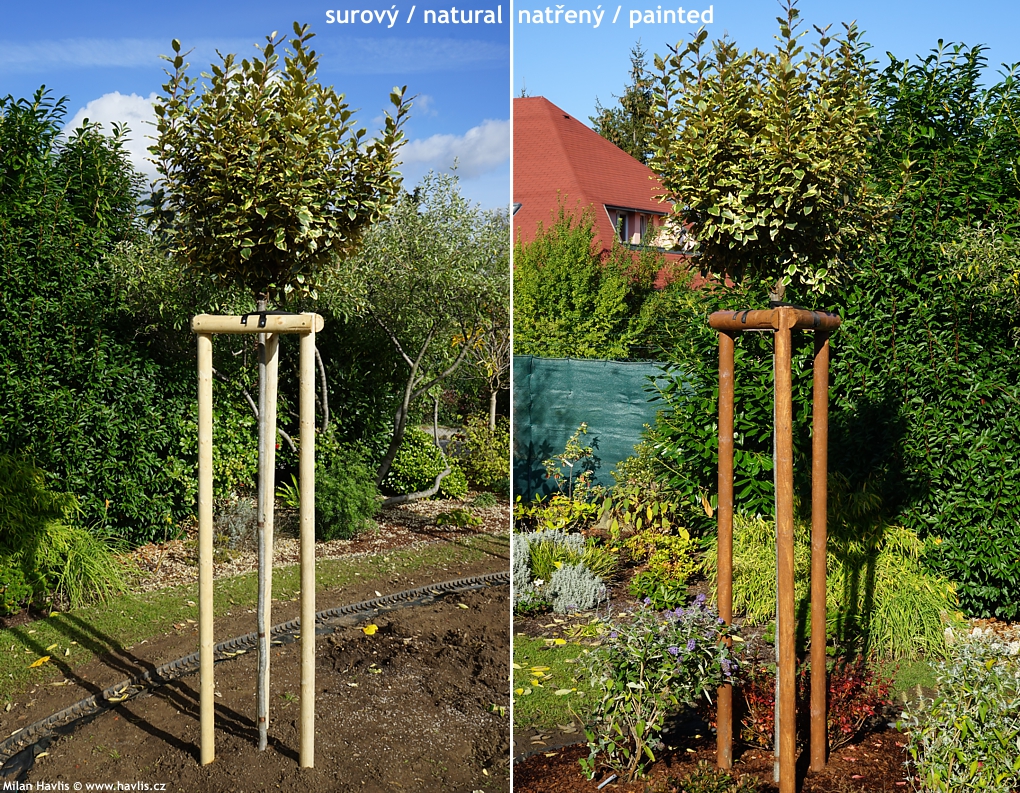Zavětrovací úvaz Tree staking set
- if its stem is taller than one meter.
- if the mass of foliage causes an obstacle for wind which would make it unstable and not upright
Staking will protect the trees from uprooting, breakage of newly producing roots, and development of crooked trunk shape caused by constant wind disturbance. We offer a complete set of a tree stake, large for standard trees, and small for half-standard trees which consists of:
- 3 pointed wooden poles
- 1 slit pole – you need to cut it into 3 parts of even size
- screws for attaching pole to pole
- nails for attaching strap to pole
- strap
Tools you will need are sledgehammer, handsaw (cordless saw or chainsaw), cordless drill, scissors, hammer. Here’s how to construct it:
1. Plant the tree. If there is a bamboo stick attached remove it.
2. Hammer the poles to the ground abt. 30-40 cm from the tree in a triangle shape. Always work in a pair so that your assistant can hold the pole for you while hammering and keep branches away from the sledgehammer.
3. If the tree is heavily branched from the ground put the poles further away – in such case you will need to purchase more slit poles.
4. The depth of poles in the ground should equal at least a quarter of what’s above ground. It doesn’t matter if the tops of the poles remain in the crown, it will be adjusted later.
5. Now take the three parts of your slit pole. Attach each part to a pair of poles with screws on the outside which will create a triangle pen. It should be just beneath the crown if possible, or at the height of minimum two thirds of the trunk height (or higher).
6. When the pen is finished take the saw and remove the pole ends above it.
7. Now take the strap and attach one end to the middle of one slit pole with a nail, run it around the trunk and back to where you started. Ask your assistant to step away to look at the tree from a distance to find the best position. When ideal attach the strap with another nail close to the first nail and cut off the rest of the strap – a holding eye is formed. Repeat the same for the remaining two sides always checking the right position from a distance.
8. When the crown is positioned and tightly secured check if the tree trunk is straight. Some trees with soft wood, e.g. albizias, and young trees (whips) could have bow-shaped trunks before they harden up. Locate the bent place and straighten it up by making another eye from the strap and attach it to the nearest pole. You do not need to do all three sides.
Your tree is now staked and you can be rest assured that it will safely root. For a good display paint the structure with a natural wood colour so it blends in with the landscape. Keep the stake on for at least 3 years, then check if the tree is well-established and then if so you may remove it. Otherwise leave it on for another year or two.
Exceptions:
- Cryptomeria japonica Globosa Nana (and similar) – the crowns are so large and heavy compared to the trunk size then it is absolutely vital to leave the stake on for good and replaced when rotten.
- If you grow vines such as campsis and wisteria as a tree then their wood remains flexible for a long time and will need a life-long support.
- Campsis trees will need an extra slit pole alongside the trunk and running to the very top of the crown and carefully attached. Their crowns are large and fragile and could break in strong wind.
- Pink flowering robinias also have fragile wood and will benefit from an extra slit pole up into the crown in locations exposed to the wind.
Conifers and large shrubs are usually fine without staking, perhaps only the taller specimens will require staking to one skew pole attached to the very middle of the trunk, hammered to the ground against the wind direction. If usure about what and how don’t hesitate to ask, we will be glad to help.
Last update 14-01-2021
Goods are shipped all over Europe. For Russia and U.K. and for further details please read about SHIPPING OPTIONS HERE.
Are you interested in a serious discount for orders NOV-FEB? Check your options here.
THE PRICES INCLUDE VAT of 15%. For quick conversion you can use 1 CZK = approx. 0.04 EUR
- STANDARD QUALITY - Plants of this group are 1st class quality with number of branches and overall density adequate to their size and age, considering they were container grown.
- DE LUXE QUALITY - This label guarantees a luxurious quality of manually selected plants that, compared to their height and age, are exceptionally dense and beautiful.
- EXTRA - These plants are usually mature and bigger specimens with exceptional overall appearance.
- STANDARD (as described in the plant form) means a tree with a trunk of 190-210 cm and a crown at the top, unless specified differently. The commercial size for trees is their girth measured in the height of 1m from ground.
- HOBBY - These plants are of the same quality as our standard-quality plants but younger and therefore cheaper.
- SHRUB - a woody plant with branches growing bushy from the ground level.
- HALF-STANDARD or MINI-STANDARD - a small tree with shorter trunk, its size is usually specified.
- FEATHERED - These are trees with branches growing already from the base of the trunk and up along the stem.
- GRASSES and PERENNIALS - Sizes given usually read the diameter of the pot or the clump, as specified.
















